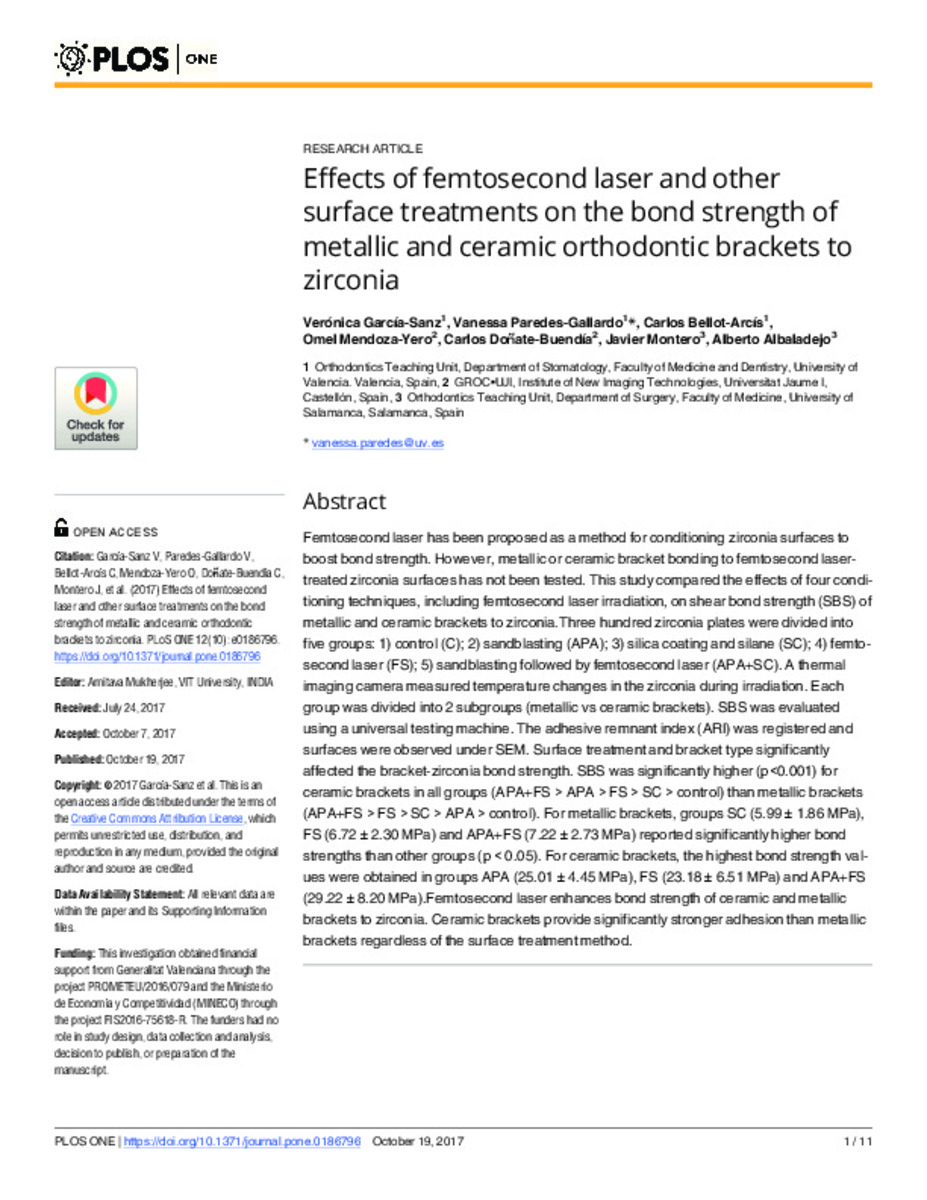Mostrar el registro sencillo del ítem
Effects of femtosecond laser and other surface treatments on the bond strength of metallic and ceramic orthodontic brackets to zirconia
| dc.contributor.author | García-Sanz, Verónica | |
| dc.contributor.author | Paredes-Gallardo, Vanessa | |
| dc.contributor.author | Bellot-Arcís, Carlos | |
| dc.contributor.author | Mendoza-Yero, Omel | |
| dc.contributor.author | Doñate-Buendía, Carlos | |
| dc.contributor.author | Montero, Javier | |
| dc.contributor.author | Albadalejo, Alberto | |
| dc.date.accessioned | 2017-12-22T13:22:20Z | |
| dc.date.available | 2017-12-22T13:22:20Z | |
| dc.date.issued | 2017 | |
| dc.identifier.citation | Garcı´a-Sanz V, Paredes-Gallardo V, Bellot-Arcı´s C, Mendoza-Yero O, Doñate-Buendı´a C, Montero J, et al. (2017) Effects of femtosecond laser and other surface treatments on the bond strength of metallic and ceramic orthodontic brackets to zirconia. PLoS ONE 12(10): e0186796. https://doi.org/10.1371/journal.pone.0186796 | ca_CA |
| dc.identifier.issn | 1932-6203 | |
| dc.identifier.uri | http://hdl.handle.net/10234/171344 | |
| dc.description.abstract | Femtosecond laser has been proposed as a method for conditioning zirconia surfaces to boost bond strength. However, metallic or ceramic bracket bonding to femtosecond lasertreated zirconia surfaces has not been tested. This study compared the effects of four conditioning techniques, including femtosecond laser irradiation, on shear bond strength (SBS) of metallic and ceramic brackets to zirconia.Three hundred zirconia plates were divided into five groups: 1) control (C); 2) sandblasting (APA); 3) silica coating and silane (SC); 4) femtosecond laser (FS); 5) sandblasting followed by femtosecond laser (APA+SC). A thermal imaging camera measured temperature changes in the zirconia during irradiation. Each group was divided into 2 subgroups (metallic vs ceramic brackets). SBS was evaluated using a universal testing machine. The adhesive remnant index (ARI) was registered and surfaces were observed under SEM. Surface treatment and bracket type significantly affected the bracket-zirconia bond strength. SBS was significantly higher (p<0.001) for ceramic brackets in all groups (APA+FS > APA > FS > SC > control) than metallic brackets (APA+FS > FS > SC > APA > control). For metallic brackets, groups SC (5.99 ± 1.86 MPa), FS (6.72 ± 2.30 MPa) and APA+FS (7.22 ± 2.73 MPa) reported significantly higher bond strengths than other groups (p < 0.05). For ceramic brackets, the highest bond strength values were obtained in groups APA (25.01 ± 4.45 MPa), FS (23.18 ± 6.51 MPa) and APA+FS (29.22 ± 8.20 MPa).Femtosecond laser enhances bond strength of ceramic and metallic brackets to zirconia. Ceramic brackets provide significantly stronger adhesion than metallic brackets regardless of the surface treatment method. | ca_CA |
| dc.format.extent | 11 p. | ca_CA |
| dc.format.mimetype | application/pdf | ca_CA |
| dc.language.iso | eng | ca_CA |
| dc.publisher | Public Library of Science | ca_CA |
| dc.relation.isPartOf | PLoS ONE 12(10): e0186796 | ca_CA |
| dc.rights | © 2017 Garcı´a-Sanz et al. This is an open access article distributed under the terms of the Creative Commons Attribution License, which permits unrestricted use, distribution, and reproduction in any medium, provided the original author and source are credited. | ca_CA |
| dc.rights | Atribución 4.0 Internacional | * |
| dc.rights.uri | http://creativecommons.org/licenses/by-sa/4.0/ | * |
| dc.title | Effects of femtosecond laser and other surface treatments on the bond strength of metallic and ceramic orthodontic brackets to zirconia | ca_CA |
| dc.type | info:eu-repo/semantics/article | ca_CA |
| dc.identifier.doi | https://doi.org/10.1371/journal.pone.0186796 O | |
| dc.relation.projectID | PROMETEU/2016/079 ; FIS2016-75618-R | ca_CA |
| dc.rights.accessRights | info:eu-repo/semantics/openAccess | ca_CA |
| dc.relation.publisherVersion | http://journals.plos.org/plosone/article/comments?id=10.1371/journal.pone.0186796 | ca_CA |
| dc.type.version | info:eu-repo/semantics/publishedVersion | ca_CA |
Ficheros en el ítem
Este ítem aparece en la(s) siguiente(s) colección(ones)
-
INIT_Articles [743]
Excepto si se señala otra cosa, la licencia del ítem se describe como: © 2017 Garcı´a-Sanz et al. This is an
open access article distributed under the terms of
the Creative Commons Attribution License, which
permits unrestricted use, distribution, and
reproduction in any medium, provided the original
author and source are credited.








